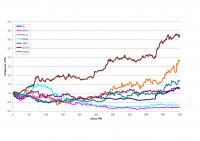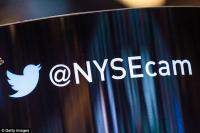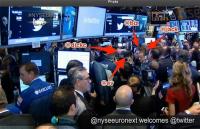Slo-Tech - Danes se bo na newyorški borzi začelo trgovanje z delnicami Twitterja. Najteže pričakovana javna ponudba delnic internetnega podjetja v tem letu se je zaključila včeraj. Za delnico podjetja je bilo treba odšteti 26 dolarjev, kar je približno polovico več od prvotno predlagane cene v razponu (17-20 dolarjev). Twitter je tako zbral okrog 1,8 milijarde dolarje svežega kapitala. Če bodo zaradi velika povpraševanja prodali še dodatne delnice (greenshoe), bo to celo več od Googla leta 2004 in drugi največji internetni IPO v zgodovini (za Facebookom). Po tem vrednotenju je Twitter vreden 14,4 milijarde dolarjev.
To je za podjetje, ki še nikoli v zgodovini ni poslovalo z dobičkom, veliko. Facebook, ki je sicer danes vreden več kot je bil na dan IPO-ja, se je ob začetku kotacije klavrno sesul, dodatne preglavice pa so povzročale tudi tehnične težave. Twitter pa je primerjalno gledano na Facebook še dražji, saj je razmerje med ceno delnice in prihodki od prodaje (P/S) 11,8. Količnik P/E pa je za Twitter negativen, saj podjetje še nikoli v zgodovini ni ustarilo dobička. Facebook ga pred IPO-jem namreč je. Precej slabo sta se po svojih IPO-jih odrezala tudi LinkedIn in Groupon, ki sta prav tako pristala bistveno nižje od cen v javni ponudbi.
15.30 Trg se je normalno odprl, z delnicami Twitterja se trgovanje še ni pričelo.
15.50 Še vedno poteka usklajevanje o otvoritveni ceni. Bloomberg neuradno piše, da sta na nakupni strani naročili za 10 milijonov delnic po 30 dolarjev in za tri milijone delnic po 40 dolarjev. (Trgovanje s Facebookom se je prvi dan začelo s peturno zamudo.)
16.00 S Twitterjem naj bi se začelo trgovati po tečaju 42-46 dolarjev.
16.25 Interval se zlagoma oži, trenutno se napovedi gibljejo v razponu 45-46 dolarjev.
16.26 Neposredni prenos s trgovalnega parketa lahko gledate tukaj.
16.40 Vrvež na NYSE je nekoliko potihnil, upadel je tudi promet z ostalimi delnicami. Vsi čakajo, kdaj se začelo trgovati bo Twitterjem. To se lahko zgodi tudi šele čez nekaj ur.
16.43 Razpon se je skrčil na 45,5-46,5 dolarjev.
16.45 Verjetno marsikoga zanima, zakaj delnice prvi dan po IPO ne začnejo kotirati ob odprtju trga. Otvoritvene cene se izračunajo v avkcijskem načinu. Vsako prodajno naročilo (če ni tržno) namreč določa minimalno ceno, po kateri se bo izvedlo, hkrati pa vsako nakupno naročilo določa maksimalno ceno. Otvoritvena cena se določi tako, da se izvede največ poslov. Če bi na tak način začeli trgovati s Twitterjem takoj po odprtju borze, bi zaradi neuravnotežene ponudbe in povpraševanja tečaj divje nihal. Zato se nekoliko počaka, da se knjiga naročil popolni in umiri.
16.50 Razpon je sedaj 45,00-45,25 dolarjev.
16.51 Trgovanje s Twitterjem se je začelo pri 45,10 dolarja.
16.52 Otvoritveni tečaj Twitterja je za 75 odstotkov višji od cene v IPO. To je za kupce v IPO odlično, za podjetje pa to pomeni, da je na trgu pustilo skoraj polovico kapitala, ker se je očitno prodalo prepoceni. Po novem vrednotenje je celoten Twitter težak 32 milijard dolarjev, kar je desetkrat več od Krke.
16.55 Tečaj Twitterja je narasel na 47 dolarjev (+80 odstotkov na IPO).
17.00 Po aktualnih tečajih je Twitter najdražje tehnološko podjetje v zgodovini, merjeno glede na prihodke, saj dobička tako ali tako nima.
17.35 Twitterjev tečaj se je malo po 17. uri dotaknil meje 50 dolarjev, potem pa je delnica izgubila 10 odstotkov. Sedaj se je ustalila med 45 in 46 dolarji.
18.00 Ustanovitelji in zgodnji vlagatelji sicer ob IPO-jih običajno ne smejo prodati vse svoje zaloge delnic niti nimajo razloga, da bi to hoteli, a vseeno vsaj na papirju tisti dan tudi formalno precej obogatijo. Soustanovitelj Evan Williams ima v lasti 10 odstotkov Twitterja, torej je njegovo premoženje zraslo za okoli tri milijarde dolarjev. Jack Dorsey, izvršni predsednik, ima v lasti 23 milijonov delnic in je pravkar postal premožen - ima okroglo milijardo premoženja v Twitterju. Dick Costolo, izvršni direktor, ima 7,5 milijona delnic oziroma tretjino milijarde dolarjev. To so le najpremožnejši, številni drugi posamezniki in zgodnji vlagatelji (skladi) so pridelali lep plus.
Novice » Rezultati » V živo: dan D za Twitter
gregor ::
o delnicah nimam pojma, ali bi npr lahko sploh kupil twitter delnice pri nas in torej danes zaslužil 75 % 
kako sploh gre ta zadeva, lahko kdo malo več pove, da vem za drugič
hvala
LP
kako sploh gre ta zadeva, lahko kdo malo več pove, da vem za drugič
hvala
LP
Zagnani ::
Kaj je zdaj to, Slo-Delnica? :|
To je delnica ameriškega podjeja, ki kotira na ameriški borzi.
o delnicah nimam pojma, ali bi npr lahko sploh kupil twitter delnice pri nas in torej danes zaslužil 75 %
kako sploh gre ta zadeva, lahko kdo malo več pove, da vem za drugič
hvala
LP
Načeloma bi lahko tudi v Sloveniji kupil delnice, mislim da preko trgovalnega računa ali pa preko nekih posrednikov, toda pri nas bi te najbrž toliko okradli z stroški, da vprašanje kakšen dobiček bi naredil.
Zgodovina sprememb…
- spremenil: Zagnani ()
Ahiles ::
Jup pri nas rabis 10 posrednikov pa davkov državi pa vsega sranja da na konc minus pridelaš
black ice ::
fosil ::
Sedaj lahko kupiš brez problema, bolj komplicirano bi bilo če bi hotel kupit v postopku IPO.
Tako je!
marvin42 ::
Zanimivo, sem mislil, da bodo pri Twitterju bolj "uganili" pravo ceno, kar nekaj denarja so pustili na mizi.
Mostly Harmless
FireSnake ::
Po aktualnih tečajih je Twitter najdražje tehnološko podjetje v zgodovini, merjeno glede na prihodke, saj dobička tako ali tako nima.
Lepo bi bilo, če bi bilo tole, sploh slednje, malo razloženo.
Poglej in se nasmej: vicmaher.si
carota ::
By Mark Hulbert, MarketWatch
At its initial offering price of $26 per share, Twitter (NYSE:TWTR) had a higher price-to-sales ratio than any other IPO since 1980 that had significant sales when coming to market.
And yet, overvalued as that suggests Twitter's stock was at its IPO, it closed Thursday some 73% higher still.
To be sure, I am not alone in arguing that Twitter is overvalued. But putting numbers to its overvaluation remains a valuable exercise, if for no other reason than to illustrate the irrational exuberance that has captured much of Wall Street.
Twitter's market capitalization at IPO was $18 billion, when taking into account -- as we should -- the number of company shares from stock options and restricted shares.
We can't judge whether this is a fair valuation in terms of a price/earnings ratio, though, as the company is losing money. In fact, its losses are accelerating, with Twitter posting a $64.2 million loss in its September quarter versus a $42.2 million loss in the prior quarter.
It isn't particularly unusual for technology companies to be losing money when they come to market, since firms at early stages of their growth cycle often sacrifice earnings in order to invest in future growth. That is why, according to University of Florida finance professor Jay Ritter, many analysts focus on sales when valuing startups and IPOs -- specifically, the ratio of a company's market cap to its total sales.
Since Twitter's sales over its most recent four quarters totaled $534 million, the company's price/sales ratio at its initial offering price was 33.8.
To put that in perspective, consider all other companies that went public since 1980 that had trailing four-quarter sales at IPO that were at least $500 million, in 2013 dollars. Prior to Twitter, the previous record was held by Palm, the hand-held device maker, whose PSR at its March 2000 IPO was 29. The next-highest was Facebook, whose price to sales ratio at IPO was 25.8.
The shares of both Palm and Facebook fell sharply over their first six months as publicly-traded companies. And their experience is more the rule than the exception. The 15 IPOs with the highest PSRs when coming to market lost an average of 5% over their first six months, according to Ritter.
What about Google, whose phenomenal growth Twitter enthusiasts are hoping can be duplicated? Its PSR at its IPO was 10.3, according to Ritter, a third of Twitter's.
One reason that a high PSR creates such headwinds for a company's shares following its IPO is that the ratio almost always declines as the company matures, often markedly. The S&P 500's current PSR, for example, is 1.4. And as the PSR declines, revenue has to rise that much faster for the stock price to just stay even.
Consider, for example, what Twitter's market cap would be in five years' time should its revenue increase at the average pace of new companies that did IPOs between 1996 and 2005. That average five-year revenue growth is 212%, according to research conducted by Ritter and Martin Kenney and Donald Patton of the University of California, Davis. If Twitter's revenue were to grow at that rate, its revenue in the fall of 2018 would be $1.7 billion.
Internet companies tend to trade at higher PSRs than the broad market, so -- to be generous -- let's assume that Twitter's will be the same as other Internet companies on the fifth anniversary of their IPOs. According to FactSet, the median PSR of the companies in the Dow Jones U.S. Internet Index on their fifth birthday was 5.87.
Given these revenue-growth and PSR assumptions, Twitter's market cap in November 2018 would be $9.8 billion, or nearly 50% lower than the $18 billion market cap the company had when coming to market.
At its initial offering price of $26 per share, Twitter (NYSE:TWTR) had a higher price-to-sales ratio than any other IPO since 1980 that had significant sales when coming to market.
And yet, overvalued as that suggests Twitter's stock was at its IPO, it closed Thursday some 73% higher still.
To be sure, I am not alone in arguing that Twitter is overvalued. But putting numbers to its overvaluation remains a valuable exercise, if for no other reason than to illustrate the irrational exuberance that has captured much of Wall Street.
Twitter's market capitalization at IPO was $18 billion, when taking into account -- as we should -- the number of company shares from stock options and restricted shares.
We can't judge whether this is a fair valuation in terms of a price/earnings ratio, though, as the company is losing money. In fact, its losses are accelerating, with Twitter posting a $64.2 million loss in its September quarter versus a $42.2 million loss in the prior quarter.
It isn't particularly unusual for technology companies to be losing money when they come to market, since firms at early stages of their growth cycle often sacrifice earnings in order to invest in future growth. That is why, according to University of Florida finance professor Jay Ritter, many analysts focus on sales when valuing startups and IPOs -- specifically, the ratio of a company's market cap to its total sales.
Since Twitter's sales over its most recent four quarters totaled $534 million, the company's price/sales ratio at its initial offering price was 33.8.
To put that in perspective, consider all other companies that went public since 1980 that had trailing four-quarter sales at IPO that were at least $500 million, in 2013 dollars. Prior to Twitter, the previous record was held by Palm, the hand-held device maker, whose PSR at its March 2000 IPO was 29. The next-highest was Facebook, whose price to sales ratio at IPO was 25.8.
The shares of both Palm and Facebook fell sharply over their first six months as publicly-traded companies. And their experience is more the rule than the exception. The 15 IPOs with the highest PSRs when coming to market lost an average of 5% over their first six months, according to Ritter.
What about Google, whose phenomenal growth Twitter enthusiasts are hoping can be duplicated? Its PSR at its IPO was 10.3, according to Ritter, a third of Twitter's.
One reason that a high PSR creates such headwinds for a company's shares following its IPO is that the ratio almost always declines as the company matures, often markedly. The S&P 500's current PSR, for example, is 1.4. And as the PSR declines, revenue has to rise that much faster for the stock price to just stay even.
Consider, for example, what Twitter's market cap would be in five years' time should its revenue increase at the average pace of new companies that did IPOs between 1996 and 2005. That average five-year revenue growth is 212%, according to research conducted by Ritter and Martin Kenney and Donald Patton of the University of California, Davis. If Twitter's revenue were to grow at that rate, its revenue in the fall of 2018 would be $1.7 billion.
Internet companies tend to trade at higher PSRs than the broad market, so -- to be generous -- let's assume that Twitter's will be the same as other Internet companies on the fifth anniversary of their IPOs. According to FactSet, the median PSR of the companies in the Dow Jones U.S. Internet Index on their fifth birthday was 5.87.
Given these revenue-growth and PSR assumptions, Twitter's market cap in November 2018 would be $9.8 billion, or nearly 50% lower than the $18 billion market cap the company had when coming to market.
frke ::
Mene pa pri twitterju moti to, da ne pozna geografije.
Slovenije kot države ne pozna. En del je je priključil Italiji (vključno z Ljubljano), en del Avstriji in en del Madžarski.
To se vidi takrat, ko twitaš z lokacijo.
Beda.
Tako je tudi s Češko in Slovaško.
Slovenije kot države ne pozna. En del je je priključil Italiji (vključno z Ljubljano), en del Avstriji in en del Madžarski.
To se vidi takrat, ko twitaš z lokacijo.
Beda.
Tako je tudi s Češko in Slovaško.
Vredno ogleda ...
| Tema | Ogledi | Zadnje sporočilo | |
|---|---|---|---|
| Tema | Ogledi | Zadnje sporočilo | |
| » | Snap začel kotirati z več kot 45-odstotno rastjoOddelek: Novice / Nakupi / združitve / propadi | 11581 (9449) | bobby |
| » | Twitter prenaglo objavil slabe poslovne rezultateOddelek: Novice / Rezultati | 13469 (10713) | eee |
| » | Twitter za vsak zaslužen dolar zapravil dvaOddelek: Novice / Rezultati | 7682 (5897) | antonija |
| » | Facebook izgubil desetino vrednosti, borza pod navalom skoraj pokleknilaOddelek: Novice / Ostale najave | 12089 (8258) | nekikr |
| » | Kitajski facebook Renren obnorel vlagateljeOddelek: Novice / Ostale najave | 6176 (4914) | 3p |


